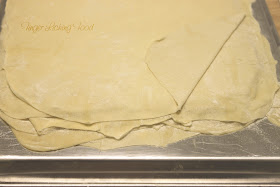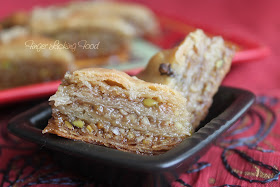This month we made Baklava, a sweet rich pastry made with layers of phyllo dough and nuts sweetened with simple syrup. Baklava is widely known as a Greek dessert, but it’s origin has really never been pinpointed as many Middle Eastern countries also name it as their own.
“Erica of Erica’s Edibles was our host for the Daring Baker’s June challenge. Erica challenged us to be truly DARING by making homemade phyllo dough and then to use that homemade dough to make Baklava.”
The actual challenge this month was making the phyllo dough at home and rolling it into sheets to be used in the Baklava. I’ve had Baklava on my mind for over a month ever since I had my first taste of it at a Persian restaurant in downtown St.Louis, MO. My friends love Baklava too and we’ve been talking about making some, and this challenge came at just about the right time. Of course I wasn’t expecting to make the sheets too, but that’s the perks of being a Daring Baker, pushing your limits and getting out of your comfort zone. :)
Phyllo, which means, "leaf" in Greek, is tissue paper-thin like sheets of dough. Homemade phyllo is a lot of work to roll out but is worth it, it’s delicious! Baklava is quite simple to make but is a little time consuming.
Recipe Source:
• Phyllo Dough Recipe - Kaffeehaus – Exquisite Desserts from the Classic Cafés of Vienna, Budapest and Prague” by Rick Rodgers
• Baklava - Adapted from Alton Brown, Food Network
Preparation time: The recipe may seem simple but it is a little time consuming
Phyllo Dough Mixing/Kneading: 15-25 minutes
Resting time: 30-90 minutes (longer is better)
Rolling Phyllo: varies, approx. 2 minutes per sheet
Syrup: 15 minutes plus cooling
Baklava: 30 minutes
Resting: Overnight
Equipment required:
Measuring spoons
Wooden dowel or rolling pin
Sharp knife
Measuring cups
Towels
Spatula
Stand mixer (can knead by hand)
Baking dishes – 9” x 9” is recommended
Strainer
Plastic wrap
Medium pot
Pastry brush
Food processor /blender
Bowls
Phyllo Dough:
- Single recipe of dough will fill a 8” x 5” baking dish.
-I doubled the recipe to yield 15-18 sheets depending on the way you roll, to fill a 9” x 2” round baking dish.
-Dough can be made ahead of time and frozen. Remove from freezer and allow to thaw and continue making your baklava.
Ingredients:
1 1/3 cups (320 ml) (185 gm/6½ oz) unbleached all purpose (plain) flour
1/8 teaspoon (2/3 ml) (¾ gm) salt
1/2 cup less 1 tablespoon (105 ml) water, plus more if needed
2 tablespoons (30 ml) vegetable oil, plus additional for coating the dough
1/2 teaspoon (2½ ml) cider vinegar, (could substitute white wine vinegar or red wine vinegar, but could affect the taste)
Directions:
In the bowl of your stand mixer combine flour and salt. Mix with paddle attachment. Combine water, oil and vinegar in a small bowl. Add water & oil mixture with mixer on low speed, mix until you get a soft dough, if it appears dry add a little more water – I had to add a tablespoon more. The dough should be very soft and slightly sticky. Change to the dough hook and let knead approximately 10 minutes. You will end up with beautiful smooth dough. If you are kneading by hand, knead approx. 20 minutes.
Remove the dough from mixer and continue to knead for 2 more minutes. Pick up the dough and through it down hard on the counter a few times during the kneading process. Shape the dough into a ball and lightly cover with oil. Wrap tightly in plastic wrap and let rest 30-90 minutes, longer is best. I let mine rest for 2 hours and it was just right.
Rolling your Phyllo
** Remove all rings and jewelry so it does not snag the dough**
Use whatever means you have to get the dough as thin as you can. This is a helpful video to get the dough thin.
You may also use a pasta machine if you have one, or a normal rolling pin whatever works for you. I used a regular rolling pin and it worked fine.
1. Unwrap your dough and cut off a chunk slightly larger then a golf ball. While you are rolling be sure to keep the other dough covered so it doesn’t dry out.
2. Be sure to flour your hands, rolling pin and counter. As you roll you will need to keep adding, don’t worry, you can’t over-flour.
3. Roll out the dough a bit to flatten it out.
4. Wrap the dough around your rolling pin/dowel
5. Roll back and forth quickly with the dough remaining on the dowel (see attached video for a visual, its much easier then it sounds)
6. Remove; notice how much bigger it is!
7. Rotate and repeat until it is as thin as you can it. Don’t worry if you get rips in the dough, as long as you have one perfect one for the top you will never notice.
8. When you get it as thin as you can with the rolling pin, carefully pick it up with well floured hands and stretch it on the backs of your hands as you would a pizza dough, just helps make it that much thinner. Roll out your dough until it is transparent. NOTE: you will not get it as thin as the frozen phyllo dough you purchase at the store, it is made by machine
9. Set aside on a well-floured surface. Repeat the process until your dough is used up. Between each sheet again flour well. You will not need to cover your dough with a wet cloth, as you do with boxed dough, it is moist enough that it will not dry out.
Baklava Recipe
Adapted from Alton Brown, The Food Network
Note: If you decide to use a 9”x2” baking pan, the entire quantity of syrup is not required.
Ingredients
For the syrup:
• 1 1/4 cups (300 ml) honey
• 1 1/4 cups (300ml) water
• 1 1/4 cups (300 ml) (280 gm/10 oz) sugar
• 1 cinnamon stick
• 1 (2-inch/50 mm) piece fresh citrus peel (lemon or orange work best)
• a few cloves or a pinch or ground clove
When the baklava is in the oven, make the syrup. When you combine the two, one of them needs to be hot, I find it better when the baklava is hot and the syrup has cooled slightly.
Combine all ingredients in a medium pot over medium high heat. Stir occasionally until sugar has dissolved. Boil for 10 minutes, stir occasionally. Remove from heat and strain cinnamon stick and lemon, allow to cool as baklava bakes.
For the Filling:
1 (5-inch/125 mm piece) cinnamon stick, broken into 2 to 3 pieces or 2 teaspoons (10 ml) (8 gm) ground cinnamon
15 to 20 whole allspice berries ( I just used a few pinches)
3/4 cup (180 ml) (170 gm/6 oz) blanched almonds
3/4 cup (180 ml) (155 gm/5½ oz) raw or roasted walnuts
3/4 cup (180 ml) (140 gm/5 oz) raw or roasted pistachios
2/3 cup (160 ml) (150 gm/ 5 1/3 oz) sugar
Phyllo dough (see recipe above)
1 cup (2 sticks) (240 ml) (225g/8 oz) melted butter - I used clarified butter or ghee as its known in India, and I used only about less than ½ cup.
Preheat oven to moderate 350°F/180°C/gas mark 4. Combine nuts, sugar and spices in a food processor and pulse on high until finely chopped. If you do not have a food processor chop with a sharp knife as fine as you can. Set aside. Trim your phyllo sheets to fit in your pan. Brush bottom of pan with butter and place first phyllo sheet. Brush the first phyllo sheet with butter and repeat approximately 5 times ending with butter. (Most recipes say more, but homemade phyllo is thicker so it's not needed)
Spread a 1/3 of the nut mixture on top. Continue layering phyllo and buttering repeating 4 times. Sprinkle 1/3 of the nut mixture. Continue layering phyllo and buttering repeating 4 times. Sprinkle 1/3 of the nut mixture on top. Continue layering and buttering phyllo 5 more times. On the top layer, make sure you have a piece of phyllo with no holes if possible, just looks better. Once you have applied the top layer tuck in all the edges to give a nice appearance.
With a Sharp knife cut your baklava in desired shapes and number of pieces. If you can't cut all the ways through don’t worry you will cut again later. A 9x9 pan cuts nicely into 30 pieces. Then brush with a generous layer of butter making sure to cover every area and edge. Bake for approximately 30 minutes; remove from oven and cut again this time all the way through. Continue baking for another 30 minutes. (Oven temperatures will vary, you are looking for the top to be a golden brown, take close watch yours may need more or less time in the oven)
When the baklava is baked, remove from oven and pour the cooled (will still be warmish) syrup evenly over the top, taking care to cover all surfaces when pouring. It looks like it is a lot but over night the syrup will soak into the baklava creating a beautifully sweet and wonderfully textured baklava!
Freezing/Storage Instructions/Tips: There are a few ways to store your Baklava. It is recommended that you store your baklava at room temperature in an airtight container. Stored at room temperature your baklava will last for up to 2 weeks. You will notice as the days pass it will get a little juicier and chewier. You may choose to store it in the fridge; this will make it a little harder and chewy, but does increase the shelf life. You can also freeze your baklava and then just set it out at room temperature to thaw.
Thanks Erica for a great challenge, it was a wonderful experience making the phyllo sheets at home and layering them in the Baklava. A sense of achievement in every bite :)


















